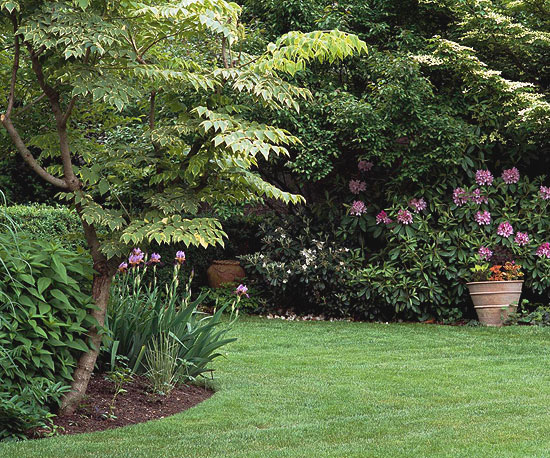






The best defense is to keep your lawn healthy by fertilizing and topdressing with organic material once a year. Mow your lawn correctly and aerate it periodically to discourage thatch buildup and soil compaction.
Lawn repair is a great way to rid your landscape of small bare, thin, or weedy patches that occasionally develop in certain areas. And repairing lawn isn't as difficult as it might seem.
The most important step in lawn repair is to deal with any problems as soon as possible so the damage doesn't spread. Weeds rapidly will fill in bare lawn areas if you don't populate that space promptly with new grass. Before you start, know that lawn repair is a two-step process.
Lawn Repair: Step One
First, try to determine the underlying cause of why you need to repair lawn. Sometimes an accident, such as a fertilizer spill, creates a bare spot in the lawn. Or the cause of the lawn repair might be chronic disease, destructive insects, or competition for light and moisture from overgrown neighboring plants. Correct these deficiencies first, or your lawn repair efforts will be futile.
See: Easy Lawn Care Tips
Lawn Repair: Step Two
To repair lawn patches, you can overseed with new grass seed. In northern states, do this in the fall, so the cool-season grasses have time to develop strong roots before they have to face summer. In southern states, repair lawns of warm-weather grasses in the spring by sprigging or plugging -- these grasses need warm weather to grow well. Consult your local nursery or home improvement store about the best lawn varieties to help ensure a successful lawn repair.
Learn more tips to successfully repair lawn.
1. Mow the existing grass as closely as possible; be careful not to scrape the crowns of the plants. Remove the clippings to expose bare soil of the repaired lawn area, so the seed will have direct contact with the soil.
2. Use a garden rake to rough up the soil between the grass plants. This, and the stubble of the freshly mown grass, will make a good seed bed for the new seed you're adding to the lawn repair area.
3. Sow seed at the rate recommended for new lawns and lawn repair. This compensates for reduced germination as some seed falls into existing grass, not on the soil.
4. Roll the lawn repair area lightly. Topdress it with topsoil or compost (optional). Water frequently. Mow the new grass when it reaches 3 inches in height.
1. Delineate the lawn repair spot you'll be repairing by digging around its border. Remove and discard any poor grass and weeds within the area. Keep the remaining bare soil free of debris.
2. Invest as much time and effort in preparing the soil in this small lawn repair area as you would for an entire lawn. Dig in organic matter and granular, slow-acting fertilizer. Rake the soil smooth and level.
3. Sow seed thickly in the lawn repair area. Use a variety that corresponds to the surrounding grass if possible. Otherwise use a mixture of grasses appropriate to the region.
Spread a thin layer of topsoil, straw, or polyspun garden fabric over the lawn repair area that you've just patched with seed. This protects the seed and, later, the sprouts. More importantly, by covering the soil, it reduces moisture loss. A constant supply of moisture is the key to good germination for a repaired lawn.
Sod is the quickest and easiest way to patch a dead or damaged turf area. You can lay it any time during the season.
Keep the sod moist until you plant it. Prepare the soil the same way you would for patching with seed. Keep the area an inch or so below grade so the new grass will be level with the lawn. Then cut a piece from the strip of sod to conform to the repair site. Firm it onto the soil, placing its edges snugly against the surrounding lawn. Walk on it to settle it into place. Water deeply and often.
Copyright © www.100flowers.win Botanic Garden All Rights Reserved